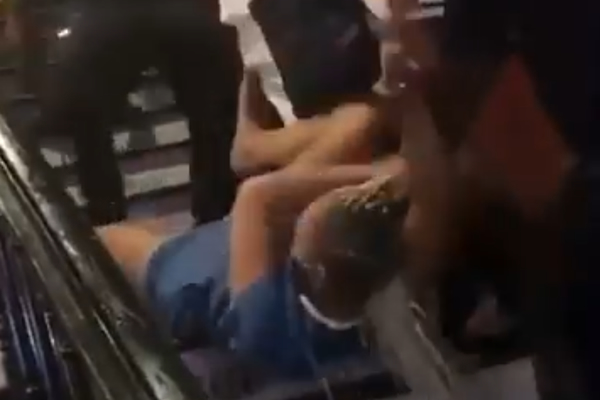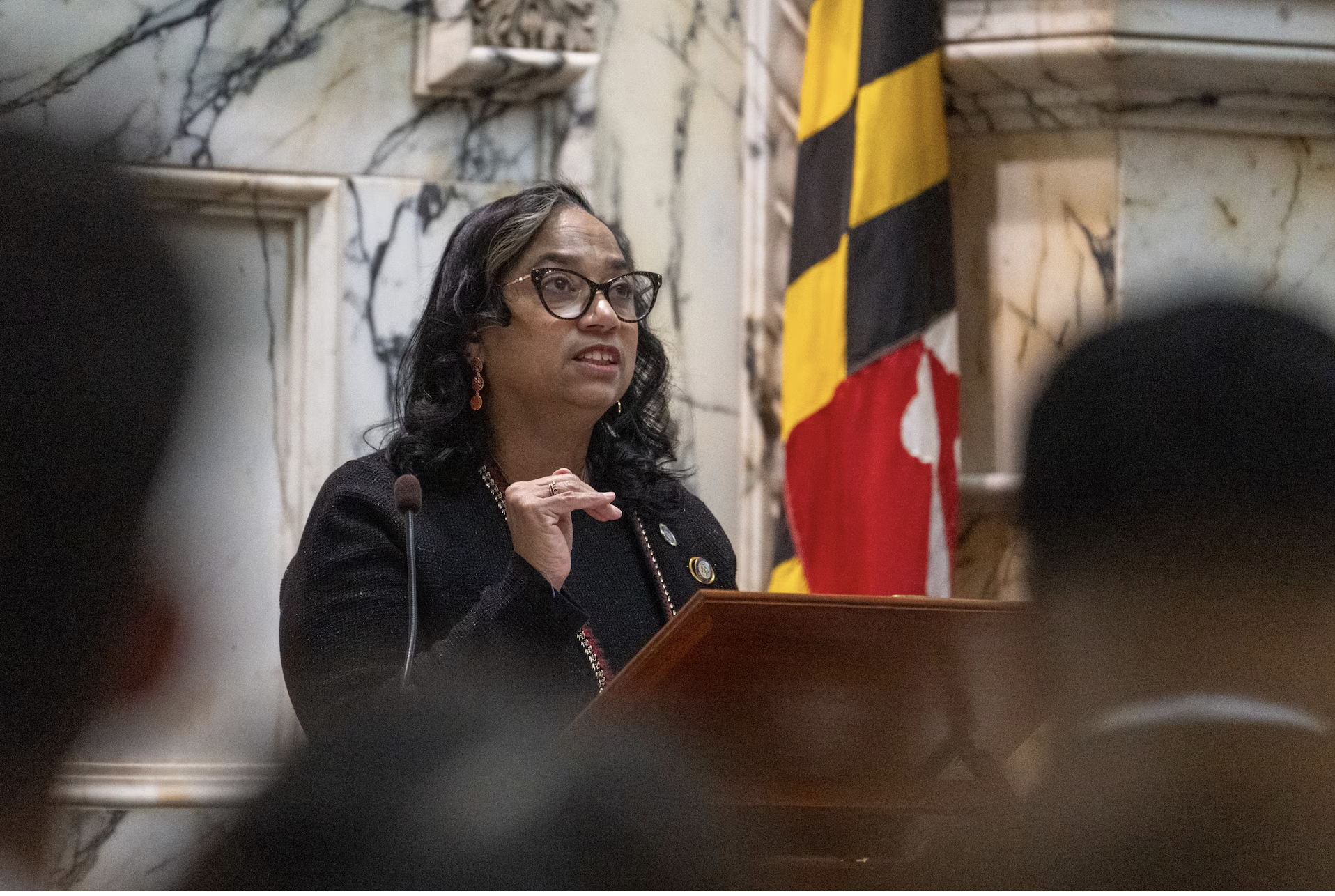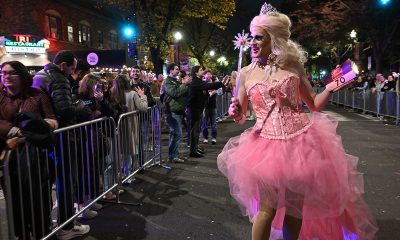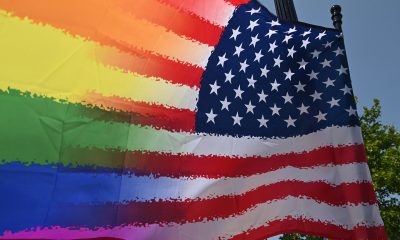Local
D.C. LGBTQ community reckons with anti-Blackness, gentrification after Nellie’s incident
Preston Mitchum among those calling for boycott of U Street bar

A video posted to Twitter earlier this month showed a member of Nellie’s Sports Bar’s security detail dragging Keisha Young, a 22-year-old Black woman, down the stairs by her hair after confusing her with a different customer who had reportedly tried to sneak liquor into the bar.
The video went viral, attracting massive online attention, including from Mayor Muriel Bowser and many others. A second video that appears to show an altercation between Young and other patrons seconds before security dragged her down the stairs has also emerged.
“Obviously, entrepreneurs enforce rules in their restaurants, but they’re not allowed to assault anybody,” Bowser told the Washington Post. “If that’s a matter for the Metropolitan Police Department, we’ll take it up.”
In a Facebook post that has since been deleted, Nellie’s responded to the surfacing of the video.
“We were incredibly upset and disturbed to see the unfortunate event that took place at Nellie’s last night,” referring to the June 12 incident. “We are undergoing a full investigation of the situation. At Nellie’s, we foster an inclusive and safe environment, so events like this are completely unacceptable to us.”
The statement garnered negative reactions online, forcing Nellie’s to issue a follow-up statement, part of which read, “We offer a heartfelt apology to all who witnessed the horrific events of the past weekend … Nellie’s will be closed this week as we evaluate this regrettable situation.”
Since Nellie’s closed and a protest in solidarity with Young was staged outside the bar on June 13, the queer community has been forced to reckon with what some describe as Nellie’s history of racist practices, as well as D.C.’s increasing gentrification.
Accusations of racism at Nellie’s are not new. Whitman-Walker Health in a June 15 tweet noted the incident that involved Young “is not the first time we have heard calls for respect for Black patrons of Nellie’s Sports Bar.” The Capital Pride Alliance in its statement about what happened to Young said Nellie’s response “will impact the CPA’s relationship with Nellie’s.”
“Over the years, the culture [at Nellie’s] became one that seemed hell-bent on pushing Black patrons out and making it a bar more for straight people and white gay men. In fact, [owner] Doug Schantz has gone on record calling his bar ‘straight-friendly’,” said Preston Mitchum, director of policy for Unite for Reproductive and Gender Equity (URGE) and a former avid Nellie’s patron.
Mitchum moved to D.C. in 2011 and started frequenting Nellie’s because of its reasonably priced drinks, which “sounded good” to him as a then-25-year-old professional.
On the alleged racial profiling at Nellie’s, Mitchum added, “I noticed that when more Black people went, particularly on Sundays, security increased. That always felt peculiar because Friday and Saturday nights were packed and had less security, based on observation. Staff also paid minimal attention to the interactions [between] white patrons. In short, there were many racist interactions and drunken behavior, and no one moved a muscle.”
Mitchum also claims that Black patrons were treated poorly compared to white customers in similar situations. He recalls incidents in which police officers were called on Black patrons and they were kicked out whereas many white patrons received warnings or “had fights broken up.”
Nellie’s in 2018 was embroiled in controversy over its display of a Blue Lives Matter flag on social media.
FOX 5 reported Nellie’s claimed to display the flag in support of LGBTQ officers who were “attending a meeting in a welcoming space.” However, many on social media were enraged by the display of the flag, which is viewed as opposing the Black Lives Matter movement, which hinges on advocating for victims of police brutality, and more importantly, reforming or abolishing the police and replacing it with community security efforts to reduce instances of racial profiling and Black deaths.
As a Black customer invested in making Nellie’s safer for him and the rest of the POC queer community, Mitchum said he participated in a number of measures to help change the culture at Nellie’s.
In a Facebook post published on his page, Mitchum wrote, “Myself and others have written letters, did interviews, conducted ‘sensitivity’ trainings, met with the owner, and even planted ourselves as observers to document our experiences.”
The efforts, however, were in vain, as according to Mitchum, Schantz did not take the efforts seriously.
For instance, Mitchum in June 2017 met with Schantz and his manager to discuss the issues at Nellie’s and to draft solutions moving forward. The meeting proved futile as Mitchum notes in a letter to Schantz, made public on social media, that among others things, asserts that Mitchum experienced rudeness from Schantz’s manager and that Schantz uttered statements with racist undertones.
“I have revisited our conversation many times and I’m still unsure of the purpose of your manager at our May 30 meeting. Not only did it create an attacking atmosphere of two-on-one, she was your ‘yes woman’ thus another person to shut down my opinion because it didn’t jive with both of yours,” penned Mitchum.
Mitchum added, “I hope you can genuinely realize that you equated hip-hop music (that uses “fuck” and the N-word) to violence … there is no valid statistical proof that creates a casual relationship between rap music and violence. Even as I pressed this fact, your response (as well as your manager’s) was ‘it’s his/my bar’ so you can play any music you like.”

Given the lack of change in culture at Nellie’s and the recent incident involving Young, Mitchum and others have called for a boycott of the bar.
A protest was staged outside Nellie’s on June 13.
The Georgetown Voice reports that Nee-Nee Taylor, co-conductor of Harriet’s Dreams (a Black-led community defense organization) said, “we ask the people to protest and boycott Nellie’s because the owner, who is a white man, don’t care about Black women.”
The Georgetown Voice also reports that Mitchum, who was present at the protest, “accused Nellie’s of relying on the business of Black patrons and gentrifying the local community while failing to care for its Black employees and patrons.”
As Mitchum reflects on how venues safe for Black LGBTQ people are disappearing, he mentions, “What was once ‘Chocolate City,’ we now see a city hovering around 50 percent Black. That’s intentional. I live a few blocks from U Street and anyone need not to be in the area to understand just how much the landscape has shifted.”
Regarding places to frequent now, Mitchum recommends Mr. Braxton’s Bar and Restaurant; Hook Hall; BIN 1301; and Fireplace.
The Washington Blade has reached out to Schantz for a response to Mitchum’s allegations but did not receive a response.
Michael K. Lavers contributed to this story.
Maryland
Joseline Peña-Melnyk elected Md. House speaker
Family immigrated to New York City from the Dominican Republic

By PAMELA WOOD | Moments after being elected speaker of the Maryland House of Delegates Tuesday, state Del. Joseline Peña-Melnyk stood before the chamber and contemplated her unlikely journey to that moment.
Born in the Dominican Republic, the Peña family lived in a small wooden house with a leaky tin roof and no indoor plumbing. Some days, she said, there was no food to eat.
When she was 8 years old, the family immigrated to New York City, where Peña-Melnyk was dubbed “abogadito” or “little lawyer” for helping her mother and others by translating at social services offices.
The rest of this article can be read on the Baltimore Banner’s website.
District of Columbia
D.C. students need academic support, diverse connections for economic mobility
Region offers array of resources for families in need of assistance

Education is the blueprint of good economic mobility.
But when students aren’t set up with the proper resources to secure a quality education, it’s often low-income families that suffer the most, For Love of Children (FLOC) Executive Director LaToya Clark said. Children from low-income families on average grow up to earn $25,600 annually, according to Opportunity Insights.
D.C. families need better economic mobility, and experts say that starts with kids getting an education and breaking generational poverty cycles. Students without a high school diploma earn $738 per week on average, while those who graduated high school earn roughly $930 per week, according to the U.S. Bureau of Labor Statistics. Contrarily, those with bachelor’s degrees earn about $1,543 per week.
Students from low-income backgrounds have fewer financial advantages on their paths to securing an education, and hardships faced by public schools make it difficult for them to catch up, Clark said.
From local financial and educational assistance programs to strengthening diversity among educators, here are a few ways researchers and advocates are fighting for better economic mobility in D.C. schools.
Student assistance programs
For many students, falling behind academically is because of circumstances outside of their control, Clark said.
She said teacher shortages, large classrooms and scarce funding can lead to an educational environment not fully equipped to set students on the right path. A one-dimensional education can then hinder future professional opportunities and give students limited economic mobility.
That’s where local organizations like FLOC come in –– to fill in the academic and social gaps often left open by schools.
Clark said FLOC has multiple services that give underserved students a more individualized academic experience. For the Neighborhood Tutoring Program, students are assessed at the grade level at which they’re performing, not what grade they are in. They’re then matched with a volunteer –– ranging from college students to retirees –– who follows a curriculum that matches the student’s performance level.
There’s also the Pathways Forward Program, an afterschool opportunity for D.C. youth in 7th to 12th grades designed to increase high school graduation rates. The program supports those at risk of academic failure to find a successful way forward, and those in 10th to 12th grades to prepare for graduation or transition to postsecondary programs. Both Neighborhood Tutoring and Pathways Forward are free.
“Everything we offer is designed to close achievement gaps, help our students boost their confidence and ensure young people have the skills and support that they need to succeed in schools and beyond,” Clark said.
And that design is working for students. Clark recalled a young girl who was the oldest of six who felt a need to help her mom take care of her siblings. She was falling behind in school until she found FLOC. The girl credited her ability to go to college and find a professional job to FLOC’s individualized and accessible approach to education.
FLOC is a reliable resource for D.C. youth to get academic help, but there are numerous other organizations working to close educational gaps and improve the future economic mobility of students.
Minds Matter D.C. helps underserved students find accessible pathways to prepare for and succeed in college. The organization offers mentoring, SAT prep, access to summer enrichment programs and guidance through the college application and financial aid process.
The work Minds Matter does addresses a disproportionate statistic: While roughly 89% of students from “well-off” families attend college, only 51% of students from low-income families do so, according to a report published by Brookings. Minds Matter reported that 100% of its students attended a four-year college or university.
The D.C. Schools Project, a program of the Center for Social Justice, offers academic help and English-language tutoring for low-income and immigrant families. Each semester, roughly 60 tutors assist about 100 students, their families, and other D.C. immigrants.
D.C. CAP Scholars has a mission to connect youth with financial and academic opportunities that will help them succeed in college. Registration is now open for the organization’s Ward 7 & 8 scholarship, a $12,000 annual scholarship for students who attended high school in those D.C. wards. Those areas encompass communities such as Congress Heights, Deanwood and Anacostia, which are some of the city’s poorest areas.
RISE offers tutoring and college mentoring to underserved populations. Its primary focus is on opportunity academies, including the three in D.C.: Ballou STAY, Luke C. Moore and Garnet-Patterson STAY. These academies are “second chance” schools for students who didn’t complete high school on a traditional timeline.
RISE Executive Director Ricardo Cooper said the organization offers real-time tutors for students in these academies through its Keep Up Tutoring program. RISE also provides summer literacy “bootcamps” and college prep for underserved students.
As a native Washingtonian, Cooper said he wishes opportunities like RISE were available to him as a kid. That’s why it’s so special for him to lead the organization and help D.C. youth rise above the academic and economic barriers he used to face.
“We know that going to college and getting a degree makes you more money,” Cooper said. “Being able to have these programs to support youth in school, to make sure that they feel confident once they graduate high school, to go to college, to feel confident in completing their coursework and just understanding the material is important to raise that poverty line.”
While these programs are crucial to many students’ success, Matthew Shirrell, associate professor of educational leadership at George Washington University, said there are many fundamental solutions to supporting kids that schools should recognize.
Diverse learning opportunities
Shirrell’s research has identified a key link to the positive relationships between teachers and students: diversity.
“Having a more diverse teaching workforce would certainly benefit all students, because it’s like their teachers having access to a library with a whole bunch of different perspectives,” Shirrell said.
He said teachers have a continuously growing list of responsibilities not just academically, but in dealing with social and emotional issues that students bring to school. By having a diverse team of educators in each school, teachers are better equipped to connect with students to turn potential barriers into new pathways.
But achieving this is about more than championing diversity –– it’s a way for students to secure better futures and stay out of the criminal justice system, Shirrell said.
Shirrell pointed to the idea of “exclusionary discipline.” In his research, Shirrell found that Black and LatinX students were significantly less likely to be suspended from school when they had teachers who shared their racial or ethnic background.
Teachers of different backgrounds than their students tend to rely on harsh disciplinary action, when in reality the situation could come down to cultural misunderstandings or misconceptions, Shirrell said.
In the long run, this disciplinary bias can disproportionately impact underserved communities. Shirrell said relentless discipline can lead to the students making poor decisions outside of school and potentially ending up in the criminal justice system.
At such a formative age, students need the support, understanding and guidance that only a diverse population of educators can bring.
“You really can’t get that from a book,” Shirrell said. “The best way to learn that is from working alongside somebody who you know is doing things differently than you. There’s tremendous value to having a diverse workforce, whether that be racial, linguistic or economic.”
Securing an education from open-minded teachers is especially important in underserved pockets of D.C., such as Wards 7 and 8. D.C. youth can experience completely different lives and opportunities just by living around the block. Diverse educators can help fill social gaps, but having students from different economic backgrounds share a classroom pushes them to see different points of views and develop their critical thinking skills, Shirrell said.
Luckily, that sentiment rings true in D.C., a city with high social capital –– or the likelihood of low-income people and high-income people becoming friends or crossing paths. About 50% of the friends of low-income people have high incomes, and low-income people are only 4.7% less likely to friend high-income people they meet, according to Opportunity Insights.
Though there’s never one simple solution in growing economic mobility for students and their families, Cooper, the RISE executive director, said having educators who embody multiple perspectives –– as well as ensure students are aware of the financial and academic support programs available to them –– are strong ways to set a child on a brighter financial and professional path.
“There are a lot of factors that also go along with [improving economic mobility], but chances are better once students feel confident in who they are, confident in what they can do and go to college and excel,” Cooper said.
This article is part of a national initiative exploring how geography, policy, and local conditions influence access to opportunity. Find more stories at economicopportunitylab.com.
Virginia
DOJ seeks to join lawsuit against Loudoun County over trans student in locker room
Three male high school students suspended after complaining about classmate

The Justice Department has asked to join a federal lawsuit against Loudoun County Public Schools over the way it handled the case of three male high school students who complained about a transgender student in a boys’ locker room.
The Washington Blade earlier this year reported Loudoun County public schools suspended the three boys and launched a Title IX investigation into whether they sexually harassed the student after they said they felt uncomfortable with their classmate in the locker room at Stone Bridge High School in Ashburn.
The parents of two of the boys filed a lawsuit against Loudoun County public schools in U.S. District Court for the Eastern District of Virginia in Alexandria. The Richmond-based Founding Freedoms Law Center and America First Legal, which White House deputy chief of staff Stephen Miller co-founded, represent them.
The Justice Department in a Dec. 8 press release announced that “it filed legal action against the Loudoun County (Va.) School Board (Loudoun County) for its denial of equal protection based on religion.”
“The suit alleges that Loudoun County applied Policy 8040, which requires students and faculty to accept and promote gender ideology, to two Christian, male students in violation of the Equal Protection Clause of the 14th Amendment to the U.S. Constitution,” reads the press release.
Assistant Attorney General Harmeet K. Dhillon of the Justice Department’s Civil Rights Division in the press release said “students do not shed their First Amendment rights at the schoolhouse gate.”
“Loudoun County’s decision to advance and promote gender ideology tramples on the rights of religious students who cannot embrace ideas that deny biological reality,” said Dhillon.
Outgoing Virginia Gov. Glenn Youngkin and outgoing Virginia Attorney General Jason Miyares in May announced an investigation into the case.
The Virginia Department of Education in 2023 announced the new guidelines for trans and nonbinary students for which Youngkin asked. Equality Virginia and other advocacy groups claim they, among other things, forcibly out trans and nonbinary students.
The U.S. Department of Education’s Office of Civil Rights in February launched an investigation into whether Loudoun County and four other Northern Virginia school districts’ policies in support of trans and nonbinary students violate Title IX and President Donald Trump’s executive order that prohibits federally funded educational institutions from promoting “gender ideology.”
-

 Congress4 days ago
Congress4 days agoEXCLUSIVE: George Santos speaks out on prison, Trump pardon, and more
-

 The White House4 days ago
The White House4 days agoWhite House deadnames highest-ranking transgender official
-

 The White House4 days ago
The White House4 days agoAs house Democrats release Epstein photos, Garcia continues to demand DOJ transparency
-

 Opinions4 days ago
Opinions4 days agoReflecting on six years on the CAMP Rehoboth board




















